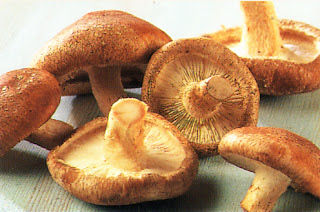How much RAW-er can you get than growing your own food? As many of you know, I recently completely an edible landscaping class and learned a great deal about using creating my own "grocery store" right outside the door of my house!
One particular class that caught my attention involved the cultivation of fungi (a.k.a. Mushrooms). See the steps I took below to inoculate logs to grow my own Shitakes and Chicken of the Wood!!
The networking of the mushroom is quite incredible and mushrooms share many characteristics with humans. Here are just a few fun factoids on mushrooms:
- Just like us, mushrooms take in oxygen for their digestion and metabolism and "exhale" carbon dioxide as a waste product. Fungal proteins are similar in many ways to animal proteins.
- Penicillin and streptomycin are examples of potent antibiotics derived from fungi. New classes of antibacterial and antiviral agents continue to be discovered in the fungal kingdom.
- Mushrooms are considered to be "immuno-modulators". When consumed, bioactive compounds (particularly protein-bound polysaccharides) in mushrooms have strong effects on our immune system.
- Just like humans, Mushrooms can produce Vitamin D upon exposure to sunlight and UV radiation.
So how does one cultivate mushrooms safely? Quite easily!! Here's what you'll need:
- Hardwood logs (the fresher cut the better). You can also use a tree stump.
- Drill
- Mushroom Spore - I ordered mine from www.MushroomMountain.com
- Rubber Mallet
- Beeswax and Brush
Step 1:
We cut down a poplar tree from our backyard (which we are replacing with a fruiting tree) and cut the trunk into approx 3 foot pieces.
Drill holes for the inoculate approximately 1" deep leaving a few inches between each hole with staggering rows.
Step 3:
Position the inoculate dowels and pound into holes using a rubber mallet. Continue until all the holes are filled. I keep the two different species of mushrooms that I was working with separate.
Step 4: Cover each plug of inoculate with a dab of melted beeswax.
TIPS:
- Stack your inoculate logs loosely to allow for the spawn to colonize. Keep the logs from ground contamination by using a pallet or other wood to stack your logs on top of.
- Keep logs protected from excessive wind and sun but ensure adequate ventilation to prevent mold from forming
- During the dry season, sprinkle the logs with water
- Be patient - it can take up to a year for spawn to colonize. Logs inoculated between Dec and May could produce a few caps by autumn.
- Harvest when caps are 70-90% open
- Let your log rest for a couple of months in between fruiting cycles and it will continue to produce for about 3 years!
Are you inpatient and can't wait for nature to take it's course? You can "force fruit" you logs by creating a 20 degree dip in temperature which tricks the log into fruiting. Here's how to tips from Lost Creek Mushroom Farm:
- Examine your log. Handle it gently. Look for signs of fruiting such as mushrooms, stems, stem holes, and pins. Pins are buds. They're all white or white with brown tips and look like "outie" belly buttons.
- Shock your log to trigger fruiting. With the log in a tray or other container, pour very cold nonchlorinated water over the log until it floats. Soak it for 24 hours. Empty the water, stand the log upright in you tray or saucer.
- Increase humidity, if needed : If you have low humidity, cover it with a paper or plastic bag and leave 2" of water in the tray. (If you have high humidity or see white mycelia or green mold, DO NOT USE THE BAG.) Do not leave the bag on for more than 5 days.
- Watch for pins: They like more moisture and may dry out, so misting will help during pinning. If pins begin to dry out, soak the log in nonchlorinated water for 30-60 minutes and the mushrooms will keep growing. Pinning. In 1-3 days, little white nubs will break through the bark. Remove the bag when the pins begin to look like mushrooms. If the pins start to dry out, soak again for 20-30 minutes or mist often.
- Fruiting. In 3-6 days, you will have a "flush" of fresh, clean, delicious mushrooms. If you don't get mushrooms, don't get discouraged. Remember that a log may not fruit after shipping. If you don't get mushrooms on your first shocking cycle, wait 3-4 weeks and shock it again. In dry or hot climates, soak overnight after two weeks. If you don't get mushrooms with the second shock, shock it every 2 weeks for 12 hours until it starts fruiting (try those 12 hrs in the fridge). If you have no mushrooms after the second round of 12 hour ice-water soaks (2 months from your original soaking)

